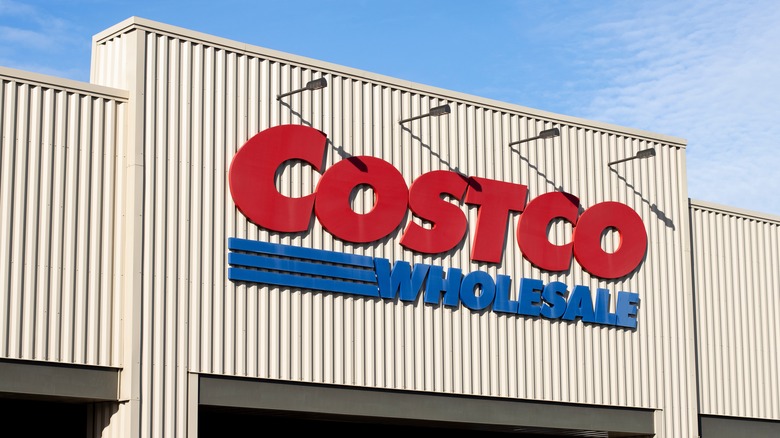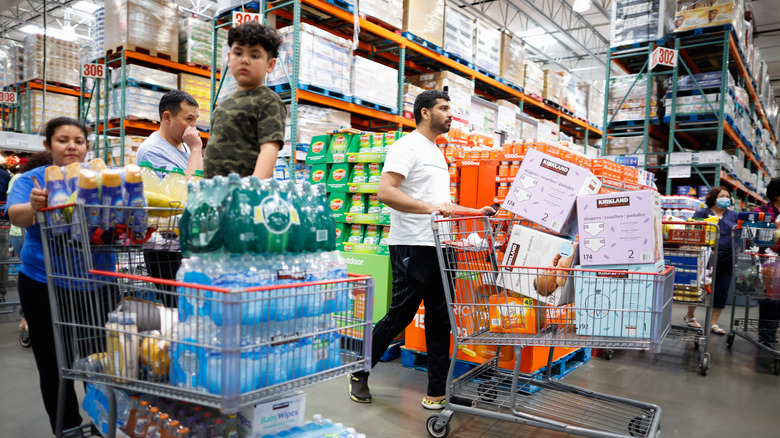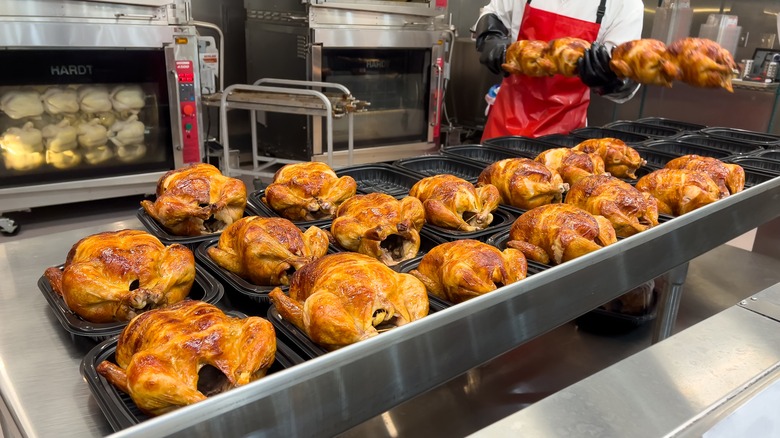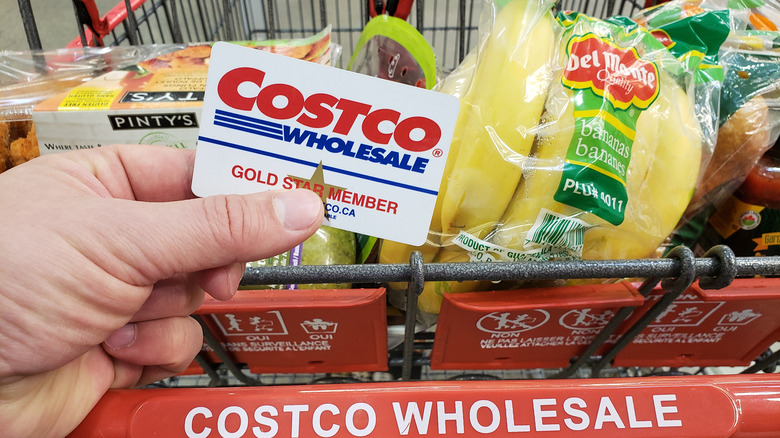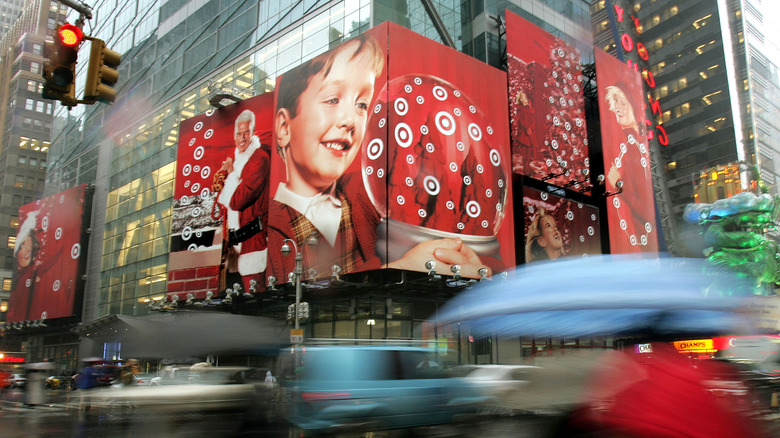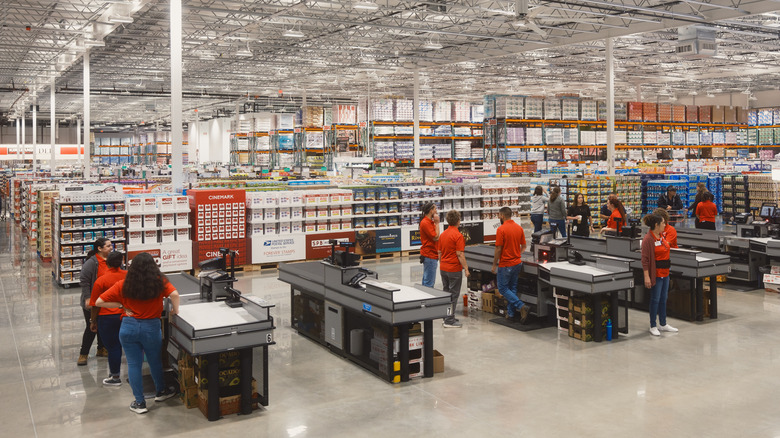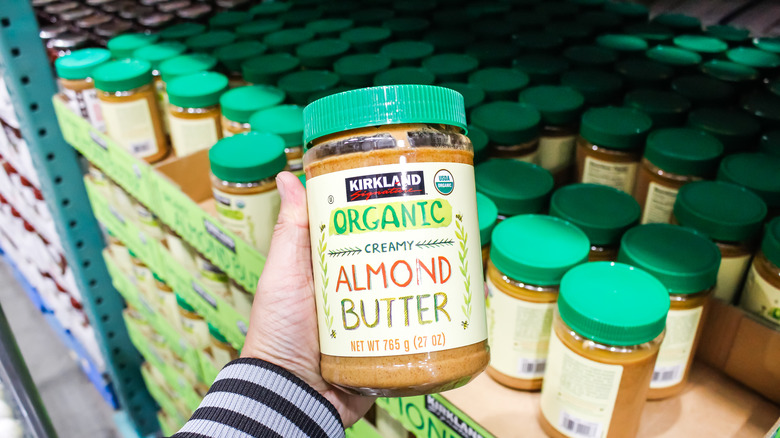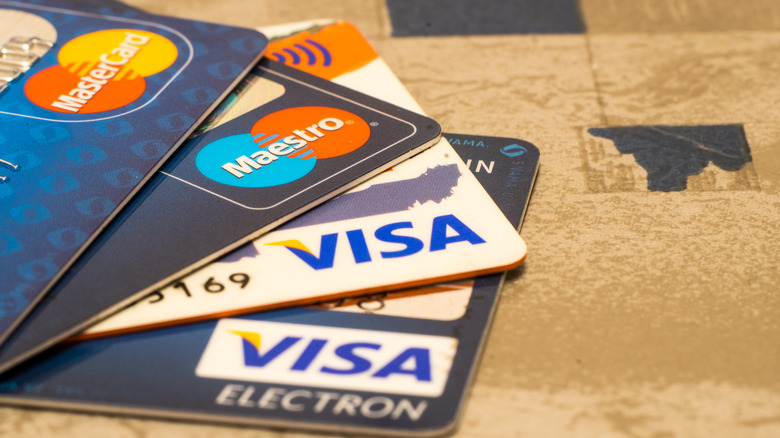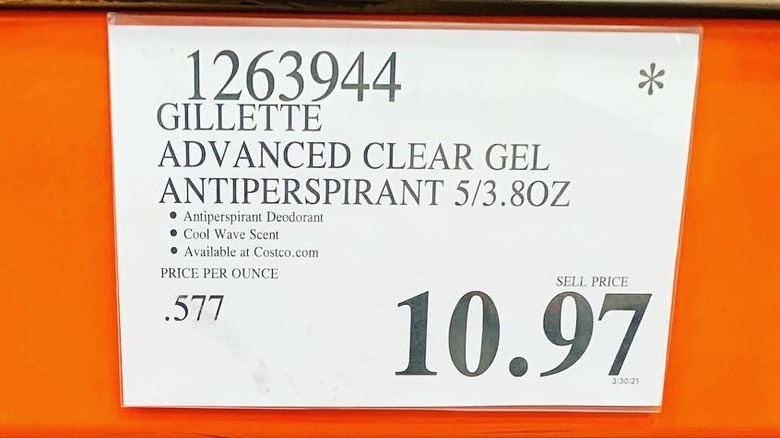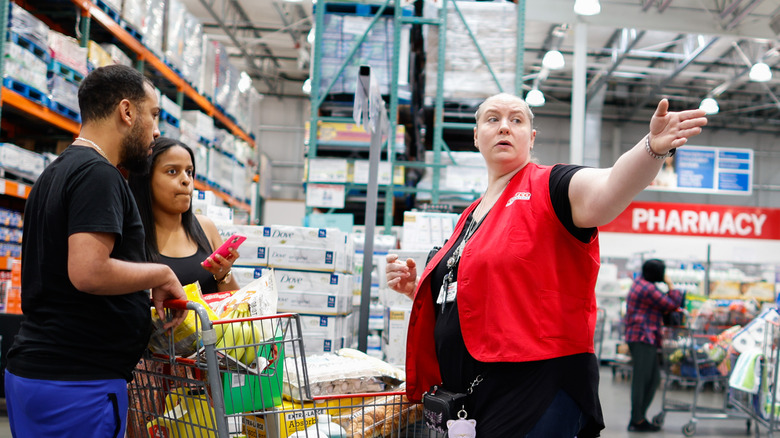Unique Features That Separate Costco From Other Grocery Stores
Costco has been shaking up the grocery store industry since its first appearance in 1983. In fact, an early version of the store, known as Price Club, started in the 1970s and was at the time the first membership-based warehouse store in the world. When Price Club and Costco merged in 1993, it became the powerhouse warehouse club we know today.
There are many things that set Costco apart from other grocery stores, and the differences don't stop at the sizes and quantities. While the bulk quantities and low prices may be the striking feature that hooks people, there are many features that set Costco's business model apart from other grocery store chains and even from other big box stores. Everything from the products it stocks, to the store layout, to its employee compensation is done with intention. It has helped Costco become not just one of the biggest warehouse chains in the United States but one that also has a cult-like following.
Costco makes money on memberships, not products
The draw of Costco has always been big sizes for small prices. Costco can offer these prices because unlike traditional grocery stores where you can enter and purchase small quantities of items at will, Costco charges a fee to enter. Most people would assume that Costco is making most of its money from sheer volume, which is true, but only to a point. Costco only makes a margin of about 11% on its products. Walmart, which owns competitor store Sam's Club, makes in the mid-20%.
That being the case, you may wonder where the rest of the revenue is coming from. It is from the membership fees people pay up front to enter the store. In 2021, for example, Costco made $3.9 billion from just the membership fees. Of course, this doesn't mean the company does not make money on its products. Still, with the guaranteed revenue from memberships, Costco is able to take a smaller margin on the products, which enables the company to offer competitive pricing, encouraging people to buy a membership.
Costco intentionally loses money on some items
Speaking of sales margins, Costco also offers a number of products that it not only doesn't make money on, but that it actually loses money on. This is a strategy known as a loss leader, which is when a company takes a loss on a product or service knowing that simply offering it will draw more people to the business and help sell other items. The difference between Costco and its competitors is just how serious Costco is about not raising the prices on some of its favorite items.
For example, when Costco first premiered the $1.50 soda and a hot dog in 1985, the pricing made sense, but since then, the price has not been raised once. It still costs just $1.50. The deal was so popular that Costco went out of its way and literally started building factories to produce its own hot dogs because that was still cheaper than buying hot dogs and selling them, plus soda, for $1.50 each. When CEO Craig Jelinek suggested raising the price even marginally, co-founder of the company Jim Sinegal responded by saying if the price went up, he would murder Jelinek. The price of a Costco hot dog and soda remained the same, and Jelinek continued to live.
Additionally, the famous Costco rotisserie chicken still holds a price tag of just $4.99 per chicken. In 2015, the company was losing upwards of $40 million on that item annually, and it's not as if inflation has slowed since then.
You need a membership, except when you don't
Unlike when Price Club first hit the scene, Costco is no longer the only membership club in the market. Many people think you need a membership to use every portion of Costco's offerings, but you do not. For example, you can purchase many items from Costco's website without a membership card. If shopping without a membership, Costco adds a 5% upcharge, but this is still lower than competitors such as Sam's Club, which charges 10%, and BJ's, which only allows purchases with a "1-Day Shopping Pass" and charges an additional 15%.
On top of that, Costco's pharmacy offers prescriptions to everyone, regardless of membership status. This is huge, as Costco prescription prices tend to be cheaper than alternative pharmacies.
Finally, at Costco, you can enter and pay with a gift card without a membership. Competitors such as Sam's Club do not allow this; in other stores, even if you have a gift card, you cannot enter the store without a membership and you cannot use the gift card towards the price of a membership.
Costco does not do traditional advertising
In this day and age, advertising is everywhere — it's on our phones, televisions, billboards, and digital screens. It feels hard to escape sometimes. But have you ever noticed one brand is missing from these traditional modes of advertising? That's right; Costco's advertising strategy is simple — it doesn't. Costco reportedly does not even have an advertising budget.
Instead, Costco leverages its membership policy as a way to appear exclusive and drive interest. It derives interest through word of mouth and social media content produced by Costco aficionados, such as The Costco Connoisseur, to drive sales. This approach is by design. The founders of the company have stated a dislike for traditional advertising and felt that avoiding the costs incurred from traditional advertising would help keep prices low and quality high, which would, in turn, bring people to the stores.
This is in stark contrast to Walmart, which spent $3.9 billion on advertising in 2022 alone. Target spent less but still managed a whopping $1.5 billion.
Costco has high employee retention rates
Costco doesn't just try to make its customers happy; it hopes to make its employees happy as well, as shown by the company's crazy high retention rate. Costco's employee retention rate is reported at 94% for workers who have been with the company for a year. Sam's Club, on the other hand, has a turnover rate of 44%, and the average retail turnover rate is at 60%.
Obviously, to have such a high retention rate, Costco is doing something right. As it turns out, Costco is doing several things right. First of all, Costco offers benefits to both full-time and part-time employees as long as they work 24 hours a week or more. Benefits include healthcare, 401k matching, and PTO. Plus, the starting wage is $17 an hour, which is more than twice the federal minimum wage which is just $7.25 an hour and has not been raised since 2009.
It is easy to see why people want to stay at Costco once they land a job there. But this model also benefits the company. Replacing an employee can cost $1500 in training alone. Costco knows that keeping employees happy pays off in the long run.
Costco only has one house brand
It is not unusual for grocery stores to offer private labels. What is unusual is to only have a single brand that covers everything from grills to eggs to booze and anything in between. Costco's brand is called Kirkland Signature. When Costco first started out, it had many house brands, much like other retailers, but co-founder Jim Sinegal saw an opportunity to streamline and improve. He saw trends toward house brands and proposed an overhaul of Costco's system — adding products and putting them all under the singular name Kirkland Signature, which premiered in 1995.
In true Costco fashion, this overhaul had thought behind it. When Sinegal revamped the house brands, he specifically looked for quality to enhance Costco's reputation. Additionally, using one singular name through all products made things easier on a corporate and legal level. It also allowed customers to easily identify the brand. Costco remains one of the only supermarket chains to use this strategy.
You can buy more than groceries there
While grocery stores and department stores were once separate businesses, it is now more common to see superstores that carry more than just food or goods. Competitors Target and Walmart both carry food and non-food items for consumers, and Costco goes beyond the offerings of a typical store.
At Costco, you can get just about anything. With a Costco membership, you can rent a car or buy a car. You can get a new battery or new tires for any car and have them installed. You can book a vacation with Costco Travel or buy new appliances. You can buy insurance for yourself, your pets, or your employees. Pick from any number of home improvement projects like fully installed floors, counters, or solar panels. You can buy clothes, books, toys, and medicine. You can even buy stamps at the checkout counter. It is honestly shocking just how much you can buy using a Costco membership. Costco uses its leverage to negotiate prices and provides rebates so that it can offer its consumers more than the average grocery store. Sam's Club offers some similar services but just does not have the same breadth of selection.
Costco only accepts Visa credit cards
Costco has proven that for them, simplicity is key. To the chagrin of many customers, though, this extends to the forms of payment it will accept. In this day and age, it is shocking to find a store, let alone an international chain leading its industry, that does not accept most credit cards. However, Costco is that industry leader and it has been that way for a while.
Between 2000 and 2016, Costco had an exclusive deal with American Express which did not permit any other cards to be used at the store. That changed in 2016 when Costco parted with American Express and signed a new deal with Visa. Under this deal, all Visa cards are now accepted in stores, as well as cash, coupons, and EBT cards, but no other credit card brands can be used. Costco did this for a number of reasons, but one of the biggest was negotiating a processing fee substantially lower for them than the standard, at just 0.4%.
It also allowed Costco to offer a generous rewards program to those who got the Visa card, noticeably more than American Express had previously allowed. The downside is that other club stores like Sam's Club and BJ's accept most major credit card brands.
Costco doesn't have a fixed inventory
Sure, we are all used to stores carrying seasonal items or occasionally discontinuing a product we love. But Costco goes even further, where items seem to leave as suddenly as items show up. One Redditor shared their joy at seeing a salad kit back on the shelves after nearly five years, coincidentally on the same day their favorite nut milk disappeared.
If you are worried about your favorite item disappearing, though, unlike other retailers, Costco gives you a warning in the form of an asterisk on the price sign. It is known as the "star of death" and means a product has not been reordered at that time. This could be because it was a limited product to begin with, or because Costco has decided to discontinue it for whatever reason.
It's also been noted that prices ending in something other than ".99" can tell you that they've been lowered or that Costco got a lower price from the manufacturer and is passing it on to customers. Any of that can be a hint that you may not see that item or price again.
The layout is ever-changing
Have you ever gone to Costco and looked for your favorite item and been disappointed to see it gone? You may assume it was discontinued by the chain, as tends to happen every now and again, only to find it in a completely new space. Or you find the bread is where the soda used to be, and the chips are suddenly across the store. It makes you crazy and leads you to wander the aisle looking for your favorite items. That is exactly what Costco wants.
The thought behind this is that while looking for the items you know and love, you will stroll up and down aisles and be struck by new items and inevitably buy more. This is clever on the company's part, which it describes as turning shopping into a "treasure hunt." To compound this, unlike stores like Target or Walmart where you can check in-store stock and location from your phone, Costco is basically uncharted territory. There are no aisle numbers or listed product sections. While the sections are broken down into very broad categories– the coolers, for example, will not move — where your groceries are within that category is your own personal treasure hunt.
